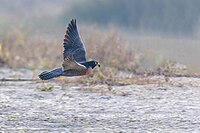Field Guide/Birds/Falco peregrinus
| Peregrine Falcon Template:StatusSecure | ||||||||||||||
|---|---|---|---|---|---|---|---|---|---|---|---|---|---|---|
 | ||||||||||||||
| Scientific classification | ||||||||||||||
| ||||||||||||||
| Binomial name | ||||||||||||||
| Falco peregrinus |
The Peregrine Falcon (Falco peregrinus) is a medium-sized falcon about the size of a large crow: 15 to 21 inches (38-53 cm) long. It has a wingspan of about 40 inches (1 m). Males weigh 570-710 grams, females weigh 910-1190 grams.
Introduction
Adult Peregrine Falcons have slate blue-grey wings and backs barred with black. Their undersides are white with light brown stripes. They have white faces with a black stripe on each cheek, and the head is blue-black. They have large dark eyes. The younger birds are darker below and browner. The females are larger than the males.
In falconry, the hen is known as a falcon and the cock is known as a tercel.
Peregrines eat mostly other birds such as pigeons, shorebirds, starlings, songbirds, parrots, and ducks. They attack their prey by flying high and diving ("stooping") at the victims.
A peregrine's diving speed can exceed 100 miles per hour (160 km/h), making it the fastest animal on earth.
The bird's Latin name, peregrinus, means "foreigner" or "traveler". This is because wintering birds often wander far from their frequently bleak breeding areas.
The call of this bird is a harsh repeated "cack".
Habitat
Peregrine Falcons live mostly along mountain ranges, river valleys, and coastlines and, increasingly, in cities. They are widespread but uncommon in Europe, Asia, North America, and Australasia.
In the USA, Peregrine Falcons used to be most commonly found in parts of the Appalachian Mountains and nearby valleys from New England south to Georgia, the upper Mississippi River valley, and the Rocky Mountains. They also lived along the Pacific coast from Mexico north to the Arctic tundra.
Courtship displays include spectacular aerobatic flight and dives by the male and aerial pursuits. A pair may mate for life. These birds aggressively defend the nesting area.
The nest is a scrape or depression dug in gravel on a cliff ledge. Sometimes peregrines will nest in a tree cavity or in an old stick nest if no cliff is available. These birds also nest on tall buildings in cities, which resemble their natural nesting sites. The female usually lays 3 to 5 eggs; the color ranges from reddish white to mottled brown.
If a Peregrine Falcon lives through its first year, it can live up to 10 years. Most young birds do not survive their first year.
Peregrines on the northwest coast of North America and other temperate regions are usually permanent residents. Birds from Alaska, northern Canada and Greenland migrate to Central and South America. Migrating birds may travel far out over open ocean.
Threats
The Peregrine Falcon became endangered because of the over-use of pesticides, in particular DDT, during the 1950s and 1960s. Pesticide build-up interfered with reproduction, thinning eggshells and severely restricting the ability of birds to reproduce themselves. In several parts of the world, including eastern North America, the Peregrine Falcon was wiped out by pesticides. In 1970, Peregrine Falcons were put on the US endangered species list.
Peregrine eggs and chicks are often targeted by thieves and collectors, so the location of their nest should not be revealed, unless they are protected.
Recovery efforts
Wildlife services around the world organized Peregrine Falcon recovery teams to breed peregrines in captivity, among other places, at Cornell University.
The birds were fed through a chute so they could not see the human trainers. Then, when they were old enough, the box was opened. This allowed the bird to test its wings. As the bird got stronger the food was reduced because the bird could hunt its own food. This procedure is called hacking. To release a captive-bred falcon, the bird was placed in a special box at the top of a tower or cliff ledge.
Worldwide recovery efforts have been remarkably successful. In the United States, the banning of DDT, over time, made it possible for released birds to breed successfully. There are now dozens of breeding pairs of Peregrine Falcons in the northeastern USA. Many have settled in large cities, including New York, where they nest on skyscraper window ledges and the towers of suspension bridges. During daytime the falcons have been observed swooping down to catch common city birds such as pigeons and starlings. The story in many other parts of the world has been similar.
External links
- http://endangered.fws.gov/facts2.html US FWS site
- http://www.peregrine-foundation.ca/ Canadian site
- http://peregrinefund.org/
- http://www.indystar.com/special/falcon/ The Falcon Cam shows a nesting pair in downtown Indianapolis
